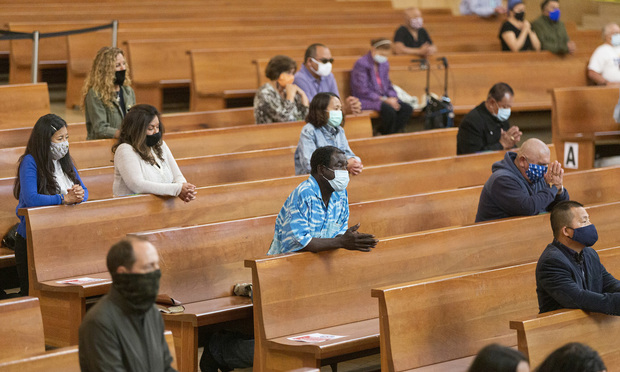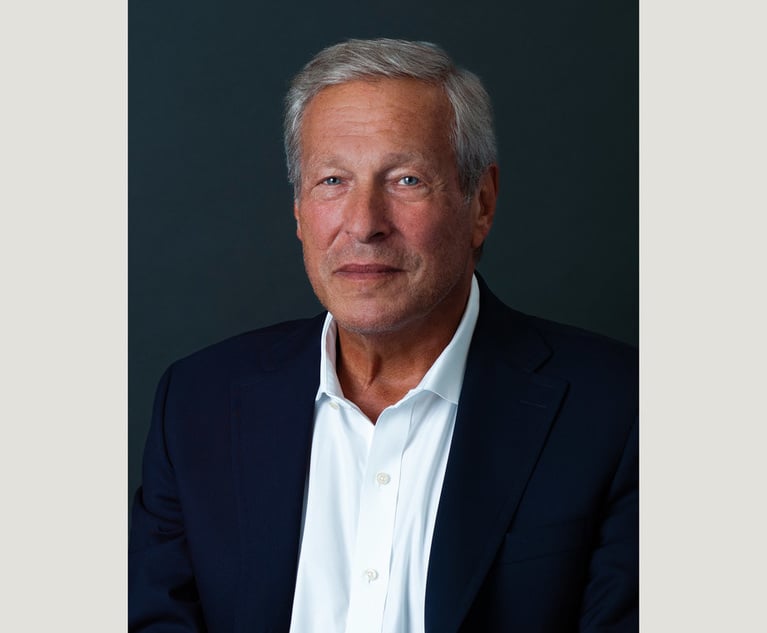The Constitution and Religious Gatherings
After Attorney General William Barr's issued memorandum was issued in April, the question is being asked "how does the Constitution limit the government's response to a public health emergency?"
June 24, 2020 at 10:00 AM
6 minute read
 Congregants kneel and observe social distancing while listening to Los Angeles Archbishop Jose H. Gomez celebrate Mass at Cathedral of Our Lady of the Angels in downtown Los Angeles, Sunday, June 7, 2020. Parishes throughout the Archdiocese of Los Angeles had suspended public Mass on March 16 amid the COVID-19 pandemic. Attendance at the Mass is limited to 100 people. (AP Photo/Damian Dovarganes)
Congregants kneel and observe social distancing while listening to Los Angeles Archbishop Jose H. Gomez celebrate Mass at Cathedral of Our Lady of the Angels in downtown Los Angeles, Sunday, June 7, 2020. Parishes throughout the Archdiocese of Los Angeles had suspended public Mass on March 16 amid the COVID-19 pandemic. Attendance at the Mass is limited to 100 people. (AP Photo/Damian Dovarganes)
In response to the COVID-19 pandemic, state and local governments imposed lockdown orders that placed temporary but substantial burdens on rights and liberties. While it is unsurprising that governments have constraining powers during times of peril, it is surprising that the constitutional limits on those restrictions are not well-understood. In April, Attorney General William Barr issued a memorandum directing U.S. attorneys to "be on the lookout for state and local directives that could be violating the constitutional rights and civil liberties of individual citizens."
Against this backdrop, we ask, how does the Constitution limit the government's response to a public health emergency? While this critical question has wide ranging implications—from the nationwide protests over the killing of George Floyd to the protests over lockdown orders to the power of government to bring about business closures—this article focuses on the constitutional limits on infringements on religious gatherings.
Jacobson's "Minimal Scrutiny"
It has been a very long time since the world has faced a pandemic on the order of COVID-19, but the power of government to act in the face of such an event is not a legal wilderness. A century-old Supreme Court decision provides significant guidance. In 1905, during a smallpox outbreak, the court decided Jacobson v. Massachusetts, a constitutional challenge to Massachusetts' mandatory vaccine statute. In finding the statute constitutional, the court recognized a fundamental principle: "In every well-ordered society charged with the duty of conserving the safety of its members the rights of the individual in respect of his liberty may at times, under the pressure of great dangers, be subjected to such restraint, to be enforced by reasonable regulations, as the safety of the general public may demand."
The court upheld the challenged restriction, holding that it could only be found unconstitutional if it "has no real or substantial relation to [public health] or is, beyond all question, a plain, palpable invasion of rights secured by the fundamental law." The court found the Massachusetts statute withstood this test.
The COVID-19 pandemic reinvigorated Jacobson. After several of the circuit courts of appeal—using a variety of tests—addressed challenges to restrictions on religious gatherings, on May 29, the Supreme Court relied on Jacobson to deny a request by a California church (in South Bay United Pentecostal v. Newsom) to enjoin Gov. Gavin Newsom's executive order, which limited in-person religious services to the lower of 25% capacity or 100 congregants. In affirming the Ninth Circuit, the court, in a concurrence written by Chief Justice John Roberts, noted that the restrictions were consistent with the Constitution's Free Exercise Clause because "similar or more severe restrictions apply to comparable secular gatherings , including lectures, concerts, movie showings, spectator sports, and theatrical performances, where large groups of people gather in close proximity for extended periods of time." The court noted that the order "exempts or treats more leniently only dissimilar activities, such as operating grocery stores, banks, and laundromats, in which people neither congregate in large groups nor remain in close proximity for extended periods."
The court made clear that Jacobson's legacy is intact: The propriety of restrictions for health and safety during such an emergency should be entrusted to elected officials and "should not be subject to second-guessing by an 'unelected federal judiciary,' which lacks the background, competence, and expertise to assess public health and is not accountable to the people." The court reaffirmed Jacobson's core principal that—absent an order that singles out religious activities—courts "[are] not in a position to second-guess expert decisions on which restrictions will be most effective at saving lives during an epidemic when those restrictions are based not on suppression of religion but suppression of an epidemic."
Varying Analysis and Results
Prior to May 29, there were multiple challenges in the U.S. to executive orders that affected religious gatherings. Many of these decisions ignored Jacobson entirely and instead applied the traditional—and less deferential—tiered-scrutiny analysis for assessing restrictions on religious activity. First, they considered whether the law is "facially neutral," i.e., whether it specifically affects only religious gatherings. If neutral, the order must meet rational basis review (easy); but, if not neutral, the order must satisfy strict scrutiny (hard)—it must be narrowly tailored to meet a compelling government need.
Analyzing very similar restrictions from different states, different courts of appeal reached very different conclusions. Some, like the Sixth Circuit, applied strict scrutiny and made clear that they would strike down restrictions. Others, like the Seventh Circuit, found the restrictions neutral because they treated comparable activities in a comparable manner.
In the South Bay Supreme Court case, Justice Brett Kavanaugh's written dissent concluded that the California order was not neutral, as the occupancy cap "indisputably discriminates against religion." The dissenters did not address Roberts' point that comparable activities were treated similarly under the California order. Instead, they compared religious gatherings to shopping for food or going to work, concluding that there was no "compelling justification" for the distinction: "the State cannot assume the worst when people go to worship but assume the best when people go to work or go about the rest of their daily lives in permitted social settings." The Jacobson approach, as reiterated in South Bay, is far better for addressing restrictions during a pandemic. COVID-19 affected everyone differently, and significant deference to elected officials and their experts (as opposed to unelected judges) is entirely appropriate—especially given how quickly public health measures needed to be implemented to quell the pandemic.
Michael de Leeuw is vice chair and Tamar Wise is a member of Cozen O'Connor's business litigation group.
This content has been archived. It is available through our partners, LexisNexis® and Bloomberg Law.
To view this content, please continue to their sites.
Not a Lexis Subscriber?
Subscribe Now
Not a Bloomberg Law Subscriber?
Subscribe Now
NOT FOR REPRINT
© 2025 ALM Global, LLC, All Rights Reserved. Request academic re-use from www.copyright.com. All other uses, submit a request to [email protected]. For more information visit Asset & Logo Licensing.
You Might Like
View All

The Marble Palace Blog: Supreme Court Books You Should Read in 2025
Law Firms Mentioned
Trending Stories
Who Got The Work
J. Brugh Lower of Gibbons has entered an appearance for industrial equipment supplier Devco Corporation in a pending trademark infringement lawsuit. The suit, accusing the defendant of selling knock-off Graco products, was filed Dec. 18 in New Jersey District Court by Rivkin Radler on behalf of Graco Inc. and Graco Minnesota. The case, assigned to U.S. District Judge Zahid N. Quraishi, is 3:24-cv-11294, Graco Inc. et al v. Devco Corporation.
Who Got The Work
Rebecca Maller-Stein and Kent A. Yalowitz of Arnold & Porter Kaye Scholer have entered their appearances for Hanaco Venture Capital and its executives, Lior Prosor and David Frankel, in a pending securities lawsuit. The action, filed on Dec. 24 in New York Southern District Court by Zell, Aron & Co. on behalf of Goldeneye Advisors, accuses the defendants of negligently and fraudulently managing the plaintiff's $1 million investment. The case, assigned to U.S. District Judge Vernon S. Broderick, is 1:24-cv-09918, Goldeneye Advisors, LLC v. Hanaco Venture Capital, Ltd. et al.
Who Got The Work
Attorneys from A&O Shearman has stepped in as defense counsel for Toronto-Dominion Bank and other defendants in a pending securities class action. The suit, filed Dec. 11 in New York Southern District Court by Bleichmar Fonti & Auld, accuses the defendants of concealing the bank's 'pervasive' deficiencies in regards to its compliance with the Bank Secrecy Act and the quality of its anti-money laundering controls. The case, assigned to U.S. District Judge Arun Subramanian, is 1:24-cv-09445, Gonzalez v. The Toronto-Dominion Bank et al.
Who Got The Work
Crown Castle International, a Pennsylvania company providing shared communications infrastructure, has turned to Luke D. Wolf of Gordon Rees Scully Mansukhani to fend off a pending breach-of-contract lawsuit. The court action, filed Nov. 25 in Michigan Eastern District Court by Hooper Hathaway PC on behalf of The Town Residences LLC, accuses Crown Castle of failing to transfer approximately $30,000 in utility payments from T-Mobile in breach of a roof-top lease and assignment agreement. The case, assigned to U.S. District Judge Susan K. Declercq, is 2:24-cv-13131, The Town Residences LLC v. T-Mobile US, Inc. et al.
Who Got The Work
Wilfred P. Coronato and Daniel M. Schwartz of McCarter & English have stepped in as defense counsel to Electrolux Home Products Inc. in a pending product liability lawsuit. The court action, filed Nov. 26 in New York Eastern District Court by Poulos Lopiccolo PC and Nagel Rice LLP on behalf of David Stern, alleges that the defendant's refrigerators’ drawers and shelving repeatedly break and fall apart within months after purchase. The case, assigned to U.S. District Judge Joan M. Azrack, is 2:24-cv-08204, Stern v. Electrolux Home Products, Inc.
Featured Firms
Law Offices of Gary Martin Hays & Associates, P.C.
(470) 294-1674
Law Offices of Mark E. Salomone
(857) 444-6468
Smith & Hassler
(713) 739-1250












